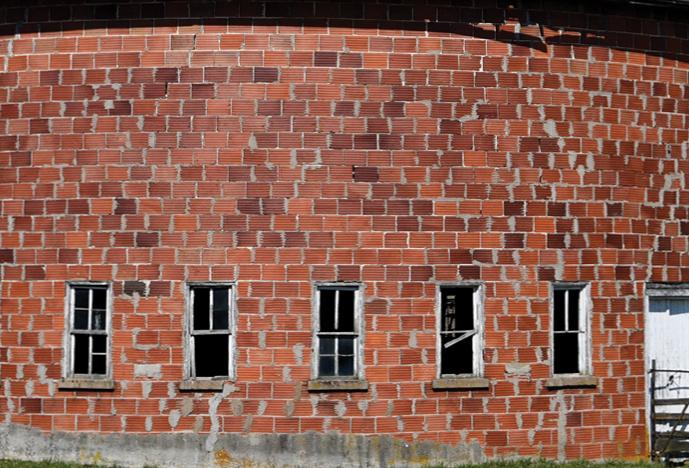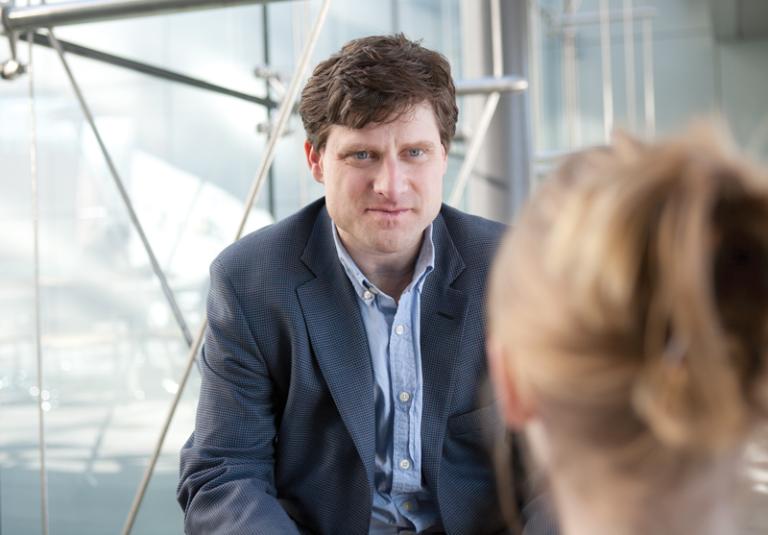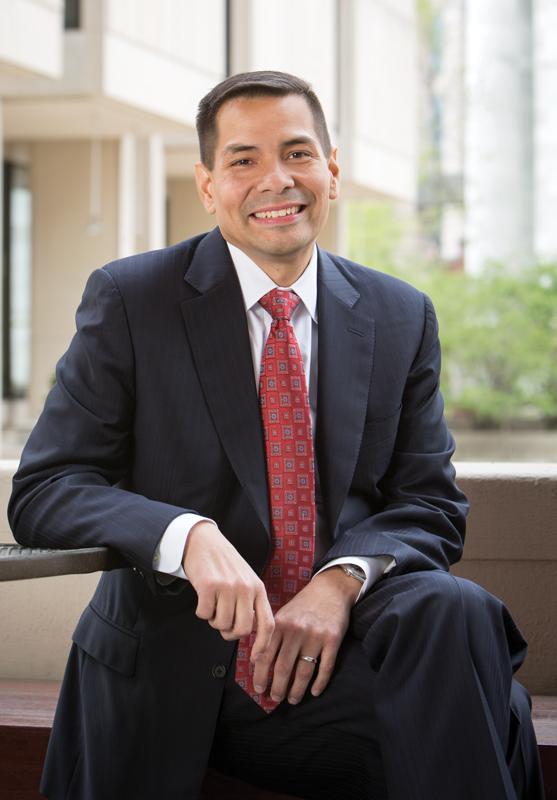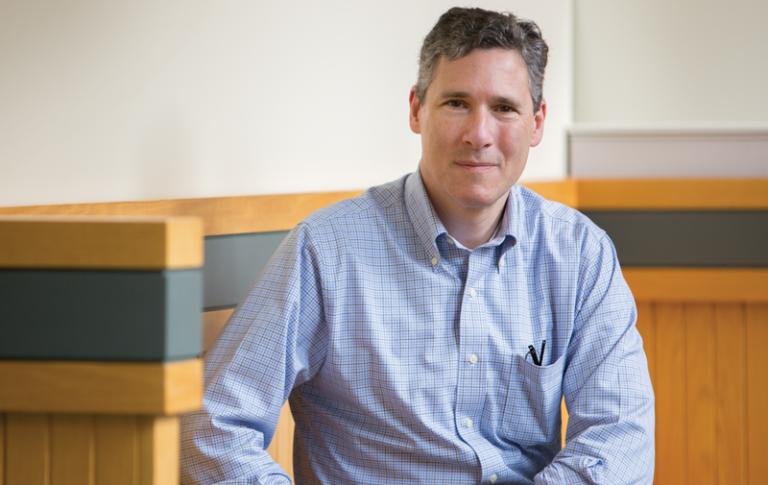Rally Round
What can be done to bolster the dwindling number of rural physicians?
- 11 minute read
- Feature

Detail from a photo of a round barn in Vernon County, Wisconsin.
It was the end of a long day at the clinic. As Byron Crouse latched the door behind him, he spotted a familiar face down the street. The woman waved. He shouted a friendly greeting, but didn’t end it with “and how are you?” He already knew. As one of the 2,000 or so souls in Spooner, Wisconsin, Crouse wasn’t just the woman’s neighbor. He was also her physician.
The bond between doctor and patient is one of the perks of practicing in a rural area, says Crouse, who worked in Spooner for years before assuming his current roles as associate dean for rural and community health at the University of Wisconsin School of Medicine and Public Health and associate chair for statewide programs in that school’s Department of Family Medicine and Community Health. “There’s a joy and a pressure to it,” he says. “It’s a different kind of patient relationship because we know them as people and want to do better for them.”
Yet the drive to provide optimal care for patients is increasingly challenging in rural areas all around the country. According to 2015 estimates from the U.S. Department of Agriculture’s Economic Research Service, roughly 46 million people in the United States—20 percent of the population—live in rural areas. But according to the American Academy of Family Physicians (AAFP), just 11 percent of physicians choose to practice in these regions. The shortage of new primary care physicians in the nation overall is amplified in its rural areas, too. These regions average just sixty-eight primary care doctors for every 100,000 patients, compared with eighty-four per 100,000 in urban settings.
Crouse thinks the nation’s rural population may be headed for what he calls a perfect storm as many of these physicians approach retirement and their patients, who are often underinsured or uninsured, age and get sicker.
The effects of this crisis are already evident: According to one estimate, there are currently more than 2,100 areas in the rural United States with shortages of health professionals, compared to 910 urban settings experiencing such shortages.

Slippery Slope
The Patient Protection and Affordable Care Act improved access to care for many living in rural areas by expanding Medicaid coverage to an estimated two million previously uninsured patients and by providing new revenue streams for rural hospitals. One analysis that looked at annual cost reports from rural and urban hospitals between 2011 and 2014 found that in states that expanded Medicaid, rural hospitals saw a greater increase in revenue from this program than urban hospitals did. These differences can likely be traced to the fact that, compared with their urban peers, a greater percentage of rural hospitals serve a greater number of low-income patients and are more likely to operate at a loss.
Now, with the fate of the ACA uncertain, rural physicians worry that their patients will suffer.
“When it comes to the way policy changes affect health care, rural patients are at the tip of the spear,” says Stephen Martin ’01, an associate professor of family medicine and community health at the University of Massachusetts Medical School. “When people are fearful that they can’t afford to pay, they don’t seek out care—even if they can access it—for chronic conditions like heart disease, arthritis, and depression. Instead, in one of the wealthiest countries in the world, we’ve got millions of people living in pain, sadness, and quiet desperation.”
Because rural medicine operates on a slim margin, even small differences can have an enormous impact on physicians’ ability to provide care. “I have grave concerns about proposed reforms to government-facilitated insurance coverage,” says Crouse. “I’m not confident that states will be as responsive to patients’ needs. I think we’re going to see a lot of uninsured rural patients, or people deciding to move out of state for cheaper care.”
Incentive Plan
On the surface, the reasons for the dearth of rural physicians seem obvious. “Most medical training takes place in cities,” says Martin, who also co-directs the Rural Health Scholars Program at UMass. “That sets doctors’ expectations for care to what can be done in urban settings. It’s difficult to compete with that.”
To address such issues, the U.S. government offers incentives to new physicians who choose to practice in rural areas. The National Health Service Corps (NHSC) offers scholarships that pay medical school expenses in return for a few years of service at an NHSC-approved high-need site. The group also has a loan repayment program that provides up to $120,000 in tuition, as well as a living stipend, to medical and dental students in their final year of school who commit to providing primary care to patients in medically underserved areas, including rural communities, for at least three years. Some physician groups, such as the AAFP, worry that the NHSC may suffer if federal health care plans change.
Another government program seeks to tap more resources by looking outside the nation’s borders for help. Since the mid-1990s, the Conrad State 30 Program, which is currently under Congressional review, has waived the requirement that foreign physicians return to their home countries for two years after graduating from U.S. residency programs. In exchange for this waiver—and the opportunity to receive a green card—physicians agree to practice in a medically underserved area for three years.

But incentivizing new physicians shouldn’t be the only goal, says Martin. “It’s not just about recruitment,” he explains. “After a few years, the question becomes, how do we get them to stay? It’s not just a matter of paying them enough.”
Resource Allocation
Many of the challenges faced by rural physicians stem from a paucity of resources, both technical and professional. In large metropolitan areas such as Boston and New York and in many smaller urban and suburban areas, it’s easy to take access to technological advancements for granted. In these places, if a patient needs a screening test—say, an MRI scan—her physician can refer her to a nearby medical center or to a department on another floor of the patient’s home clinic. With a few keystrokes and a phone call, she has an appointment, and, in less than an hour, could be in the MRI suite.
In less-populated regions, however, a patient in need of an MRI scan may have to travel hours to the nearest hospital. That trip becomes even more difficult when you consider that patients in underserved and isolated communities can face obstacles that go beyond distance, such as a lack of public transportation or weather conditions that may make travel dangerous or roads impassable.
These challenges can have a troubling impact on the health of rural patients. One study found that for American Indian and Alaska Native people, the time between onset of heart attack symptoms and arrival at a hospital far outstrips that for any other racial or ethic group. Research by Thomas Sequist ’99 and his colleagues found that members of these communities are also less likely than their white peers to undergo procedures such as angioplasty or heart bypass surgery, primarily because their rural communities don’t have cardiac catheterization facilities. Another study found that excessive travel time to transplant evaluation centers—often more than three hours in each direction—does more than inconvenience American Indian and Alaska Native patients with end-stage kidney disease: It likely contributes to Sequist’s finding that American Indians are 60 percent less likely to receive a renal transplantation, compared to their white peers.
This scarcity of specialty care is one of the greatest areas of concern for rural practitioners, says Sequist, an HMS associate professor of medicine and of health care policy and the medical director of the Brigham and Women’s Hospital Physician Outreach Program with the Indian Health Service (IHS). But the scarcity may be linked to small patient populations.
“Whether in rural New Mexico or Nebraska, there just aren’t necessarily hundreds of patients with, for example, rheumatoid arthritis, in a single isolated community,” Sequist says. “Unfortunately, that means it’s hard to justify supporting and retaining a full-time rheumatologist—there just isn’t enough work.”
As a result, some of the care that would otherwise be provided by specialists can fall on the shoulders of primary care and family medicine physicians. Indeed, the same study by Sequist found that fewer than one-third of physicians in the IHS reported good access to specialty care. And that lack, in turn, produces a catch-22: more than half said that the complexity of care they were asked to manage without specialty input was greater than they thought it should be.
Often, these challenges add to an already substantial workload, setting the stage for fatigue and burnout.
“From a cost perspective, rural practices are at a disadvantage,” says Bruce Landon, an HMS professor of health care policy and a professor of medicine at Beth Israel Deaconess Medical Center, “and they’re stretched from a human resources perspective. In many of these practices, the physician is also the IT specialist and the nurse is also the receptionist. They don’t have the economies of scale we see in urban settings.”
Worse, there’s often little backup from other physicians. “In medicine, just as in sports,” says Crouse, “you want a good bench supporting you. In rural practices, there is no bench—it’s just one physician providing care for people in multiple counties in a region.”
“What happens if that doctor moves or dies?” he adds, “When one person leaves, there’s a huge impact.”
Sequist expands on Crouse’s point. “Physicians who choose to work in rural areas are incredibly dedicated to patient care,” says Sequist, “but the community of other doctors is usually limited.”
“Rural physicians don’t just leave because they can’t afford to pay off medical school debt on a rural salary,” Sequist adds. “They leave because they want a community to turn to for professional and emotional support.”
Concerns about community extend to physicians’ families as well. Depending on their life stage, doctors and their families must determine whether a rural community is a good fit for everyone, from the quality of schools to the social and employment opportunities for other family members. If anyone in a family feels estranged from a supportive community, it’s likely the family won’t remain there long.
The Mother of Invention
Although the hardships of practicing medicine in rural areas may seem overwhelmingly complex, rural physicians often emphasize the benefits. In many ways, they say, rural regions are incubators for innovative approaches to patient care. For years, rural practitioners have been generating creative solutions to deliver quality care to patients with complex needs while operating on slim budgets and with limited staff support.

“Areas with substantial resource constraints have much to teach the rest of the country about how to squeeze unnecessary elements out of patient care and focus on what works,” says Martin. “We joke that it’s a MacGyver approach. But it can work really well. And it can give us powerful lessons for nimble and flexible care provision.”
One such approach involves hiring other health professionals to support rural physicians. Community health workers can assist doctors by performing outreach within underserved areas, educating patients, and helping to ensure that residents seek out and receive care. Medical scribes can also help ease physicians’ workloads by gathering information, documenting visits, and otherwise taking on clerical tasks that can consume time needed for appointments. As a result, a physician can increase revenue by seeing more patients while also spending more time with each of them.
“Losing a doctor is a loss for everyone, so we need to keep people happy and productive,” says Crouse. “Scribes and other types of assistants can do that by improving quality of life.”
Technology can also open up new opportunities for patient care. For nearly two decades, the IHS has had a tele-ophthalmology program to screen patients for diabetic retinopathy at remote clinics without onsite vision specialists. Digital retinal images taken at the clinic are sent electronically to faraway ophthalmologists for interpretation. Feedback from specialists helps local physicians identify patients who need to travel to receive treatment or further evaluation, saving some patients unnecessary travel and controlling costs for the IHS, which pays for patients’ travel to receive outside specialty care.
Sequist and his colleagues at Brigham and Women’s are also using technology to share the expertise of HMS physicians with physicians practicing in isolated areas. As part of the hospital’s Physician Outreach Program, Sequist and others use videoconferencing to provide rural clinics in the IHS with continuing education programs, clinical consults, and case reviews. “The Indian Health Service has really innovated in the space and pushed telemedicine in ways that physicians in urban environments haven’t had to do,” says Sequist.
The Brigham and Women’s model allows for Boston physicians to volunteer their services at clinics in remote parts of New Mexico and Arizona, and for bringing rural physicians to the Boston hospital for annual training programs. Such an exchange of ideas and inspiration is one that Martin hopes to see expand throughout the country.
“We need to reach out to rural physicians, because they have a lot to teach medical students and other doctors,” he says. “They are doing remarkable work and we need to honor that experience.”
Images: Boscophotos, Wikipedia (top); John Soares